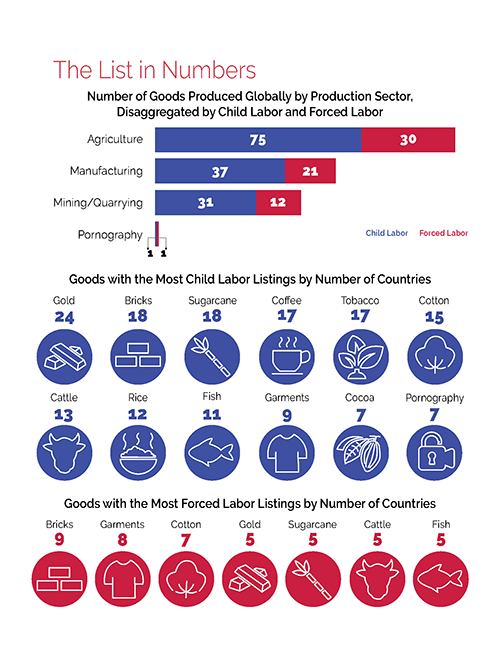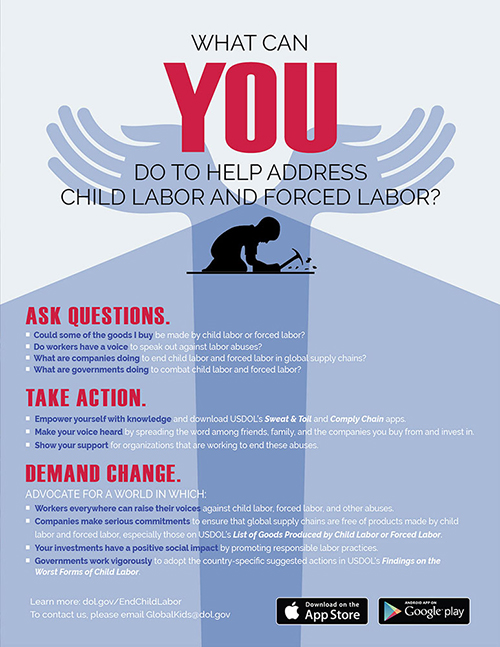List of Goods Produced by Child Labor or Forced Labor
The Bureau of International Labor Affairs (ILAB) maintains a list of goods and their source countries which it has reason to believe are produced by child labor or forced labor in violation of international standards, as required under the Trafficking Victims Protection Reauthorization Act (TVPRA) of 2005 and subsequent reauthorizations. The List of Goods Produced by Child Labor or Forced Labor comprises 159 goods from 78 countries and areas, as of September 28, 2022.
ILAB maintains the List primarily to raise public awareness about forced labor and child labor around the world and to promote efforts to combat them; it is not intended to be punitive, but rather to serve as a catalyst for more strategic and focused coordination and collaboration among those working to address these problems.
Publication of the List has resulted in new opportunities for ILAB to engage with foreign governments to combat forced labor and child labor. It is also a valuable resource for researchers, advocacy organizations and companies wishing to carry out risk assessments and engage in due diligence on labor rights in their supply chains.
The countries on the List span every region of the world. The most common agricultural goods listed are sugarcane, cotton, coffee, tobacco, cattle, rice, and fish. In the manufacturing sector, bricks, garments, textiles, footwear, carpets, and fireworks appear most frequently. In mined or quarried goods, gold, coal and diamonds are most common.
ILAB published the initial TVPRA List in 2009 and updated it annually through 2014, following a set of procedural guidelines that were the product of an intensive public consultation process. ILAB now updates and publishes the List every other year, pursuant to changes in the law.
Procedural Guidelines
On January 25, 2024, ILAB's Office of Child Labor, Forced Labor, and Human Trafficking published Procedural Guidelines for the development and maintenance of the List of Goods from countries produced by child labor or forced labor in violation of international standards.
| Country/Area | Good Sort ascending | Exploitation Type |
|---|---|---|
| Iran | There are reports that children ages 7 to 17 produce bricks in Iran. Media reports indicate that most brick kiln workers are Afghan migrants whose children work alongside them in the summer months. There are reports of child labor in the production of bricks in various parts of the country, including Tehran, Shahr-e Rey, and Gorgan. For example, available data indicates that there are 25,000 workers in brick kilns in Tehran Province, and news articles report that in one town in Tehran Province, the majority of the brick kiln workforce consists of school-aged children who do not attend school. According to Iranian news outlets, children in the brick kilns work more than 8 hours a day and are exposed to injuries, dust, and extreme heat. |
Child Labor |
| Korea, North | Forced Labor | |
| Nepal | There are reports that children ages 6-17 and some younger than age 5 are working under conditions of forced labor to produce bricks in Nepal. According to available information from an NGO report, two-thirds of the children are male. Brick kilns are concentrated in the Kathmandu Valley and Terai, and operate seasonally between October and June. According to the most recently available NGO data, between 30,000 and 60,000 children work in Nepal's brick kilns, of which up to 39 percent are working as bonded labor. Migrant families, members of certain castes – a socially disadvantaged class in Nepal – and ethnic minorities, such as Dalit, Janajati, and Madeshi, are particularly vulnerable to bonded labor in brick kilns. Most of the children are from Nepal, however some are from West Bengal and Uttar Pradesh, India. Many families take advance loans from brick kiln employers or brokers with a commitment to produce a specified quantity of bricks, and become bonded laborers. Their children are bound by their parents' debt and work alongside their families making bricks. The bonded families live at the kiln worksites, without access to safe water or sanitation facilities, and are prohibited from leaving until the debts are paid in full. Some bonded children are forced to work 12 hours a day, and receive little, if any, payment after wage deductions to repay the family debt. Some children are penalized by their employers with verbal or physical abuse. |
Child Labor, Forced Labor |
| Pakistan | There are reports that children in Pakistan work under conditions of forced labor producing bricks. According to the most recently available data from the media, the ILO, and a university study, there are hundreds of thousands of these children across Pakistan. The brick industry uses a system of bonded labor under which children, from a very young age, often work alongside their debt-bonded families. Because the debts are sometimes inherited, many children are born into the bonded labor. Under the Pakistani “peshgis” bondage system, families are not free to leave the kiln, and are forced to produce quotas of 1,000 or more bricks per day under threat of physical violence or death. Brick workers, including children, are forced to work without masks, goggles, gloves, shoes, or other safety equipment. |
Child Labor, Forced Labor |
| Paraguay | Child Labor | |
| Peru | Child Labor | |
| Russia | There are reports that adults are forced to produce bricks in Russia. Both men and women are exploited for forced labor in informal brick factories in the Northern Caucasus region of Dagestan; however, victims are primarily male job-seekers recruited in Moscow. According to a local NGO and media reports, hundreds of individuals have been subjected to forced labor in brick factories. Recruiters in Moscow frequently drug and abduct victims who are then sold to brick factory owners in Dagestan. Other victims are recruited through deception regarding the location of work and the anticipated wages. Victims and a local NGO report that factories frequently withhold all wages, sometimes confiscate workers’ passports and cellphones, and sometimes use physical violence, especially when workers try to leave. |
Forced Labor |
| Uganda | Child Labor | |
| Vietnam | Child Labor | |
| Bolivia | There are reports that children are forced to harvest Brazil nuts in Bolivia. Forced child labor in the production of Brazil nuts is known to be found in the Amazon region in particular, and migrant workers are particularly vulnerable. According to international organizations, NGOs, and the U.S. Department of State, many children are forced to work, often with their families, under conditions of bonded labor. Often entire families, including children, are given an advance payment to work in the harvest, and then incur more debt during the harvest. The families are prohibited from leaving, even once the harvest is complete, until their debts are paid off. Sometimes identity papers and wages are withheld as a means to restrict freedom of movement. |
Child Labor, Forced Labor |
your hand? Download ILAB's Sweat & Toil App today!
Are you a company looking to fight child labor and forced labor in supply
chains?





